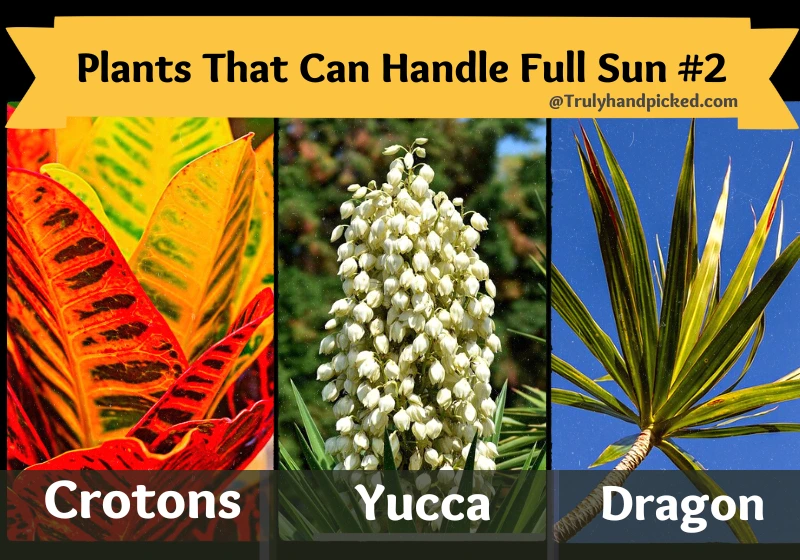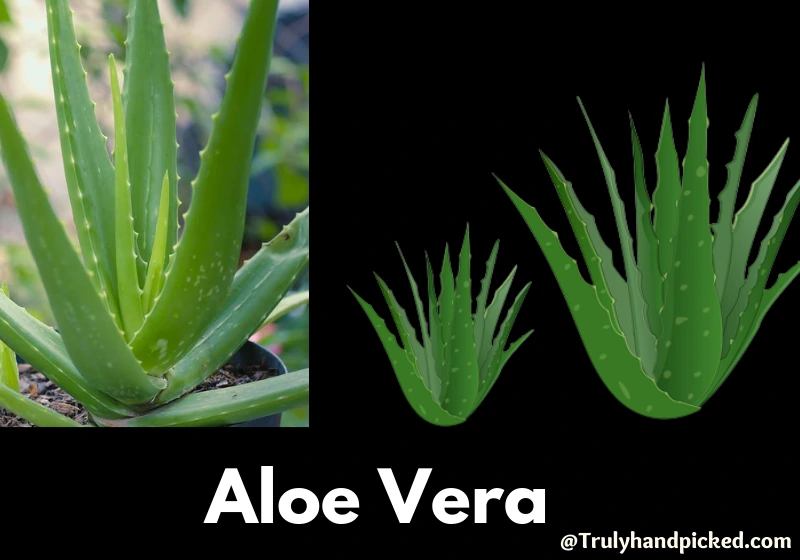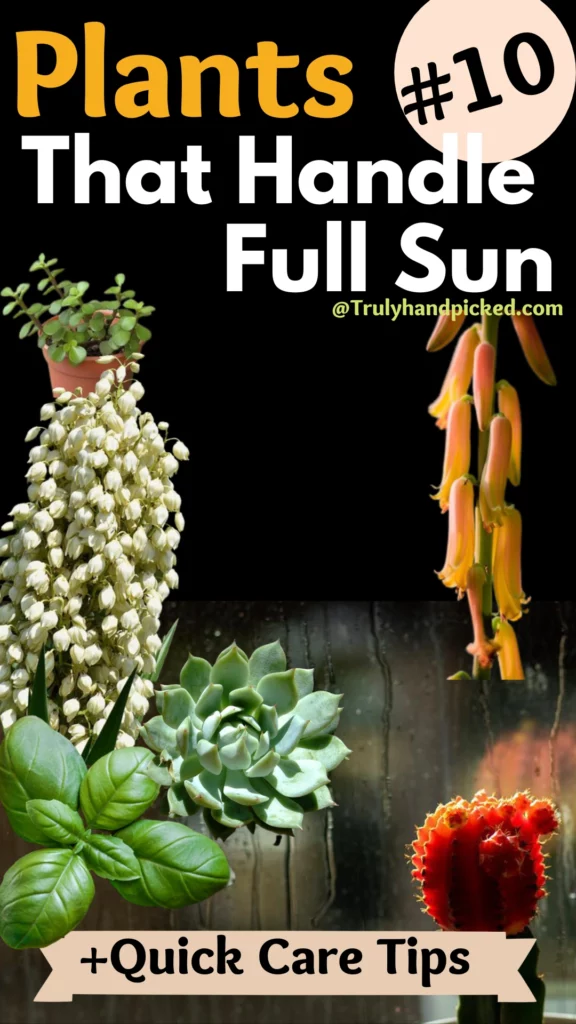Taking care of houseplants becomes more effortless when you don’t need to worry about the placing spot of the planter. Plants with low or indirect light requirements always seem tricky to handle due to their specific needs.
But houseplants, which can do fine under bright and direct sunlight are easier to look after. You just need to provide some common fundamental growing conditions and a spot where the plant can grab its essential sunlight adequately.
10 Best Indoor Plants That Tolerate Direct Sunlight

Here we come up with the best 10 houseplant options, which do extremely well when placed simply in a sunny window or luminous balcony-
Jade Plant:
The Jade plant is a spectacular-looking succulent with a vivacious shade. Apart from bright sunlight, it claims only a moderate amount of care to thrive beautifully. If you keep the plant away from direct sunlight for a long, it will turn leggy and top-heavy shortly.
Soil: Jade plants love Well-drained, slightly acidic soil prepared with cactus mix
How Often to Water: Once every week to keep the soil evenly moist
Fertilizer: Apply any balanced water-soluble fertilizer once every 4 months
Climate: Keep the temperature between 65° to 75° F and place your planter in a moderately humid place
Geranium:
This is a stunning flowering plant that only thrives under consistently bright and direct sunlight. If you keep the planter away from direct sun for a long, the geranium’s green foliage will turn black with detectable mold infestation.
Soil: Geranium is okay with any fluffy normal potting mix with well-drained quality and acidic pH level
Water: Once every 7-10 days and let the soil dry between watering
Fertilizer: Feed your plant with an all-purpose dry fertilizer every 4-6 weeks with a 5-10-5 NPK ratio
Climate: Maintain the temperature level of 60-65° F for nighttime and 70-75° F for daytime with 50% of humidity
Echeveria:
Echeveria is a flower-shaped succulent that is mostly found in mountain or desert areas. This evergreen succulent species may face several growing issues like stunt growth, falling leaves, curly foliage, etc. due to inadequate sunlight.
Soil: Well-drained soil that is prepared with perlite and coarse sand along with a normal potting mix
Water: Every 7-8 days and let the soil dry completely between watering sessions
Fertilizer: Doesn’t need fertilization at all, to provide the light source, only rotate the planter once in a while
Climate: Maintain the temperature around 70° F with a low to medium humidity

Crotons:
Croton is a big foliage ornamental plant with catch and colorful leaves. Most of the varieties of this species claim high light to thrive properly. If you keep the planter in low light for a long, it may get colorless leaves and curly edges, when the new foliage appears.
Soil: Moist, well-drained soil with an acidic pH level
Water: Keep the soil evenly moist with frequent watering but let the soil dry a bit between watering
Fertilizer: Apply any balanced liquid fertilizer every 2-3 weeks during the growing seasons in a 20-20-20 NPK ratio.
Climate: It prefers a warm climate with a temperature of about 60° or more with a moderate humidity level. Don’t forget to use a humidifier or misting process to keep the humidity level up during the entire growing session.
Yucca Plant:
The Yucca plant is a perennial shrub that grows easily in a wide sunny location. This species of the Asparagaceae family produces spectacular blossoms in white stalk form. A Yucca plant will have greener and yellowish foliage, as well as leaves-falling problems, with the low-light condition.
Soil: Well-drained soil prepared with sand and perlite with a 1:3 ratio
Water: Water the plant every 14 days by making the top 2-2.5 inches of soil moist deeply
Fertilizer: Any time-released fertilizer rich in nitrogen content, once every 3-4 months
Climate: Normal or moderate humidity level with 65° to 85° F temperature under full sun exposer
Dragon Plant:
Dracaena marginata is a classy-looking subtropical plant, that could do effortlessly well as a houseplant when placed in the right spot. Dragon plants are pretty hardy and can tolerate 9-11 hardiness zones easily. Plants will start growing slower and produce tinier leaves if they stay in low-light conditions for a long.
Soil: Loamy, well-drained soil with neutral to the acidic pH level
Water: Wait till the top half of the planter soil gets dry between your dragon plant’s watering sessions and always use distilled water
Fertilizer: Apply any balanced controlled released fertilizer in liquid form during the growing seasons only
Climate: Maintain the temperature between 70° to 80° F with a normal home humidity level

Ponytail Palm:
Ponytail palm aka elephant’s foot is a huge and exclusive houseplant that requires a lot of space to thrive, along with bright sunlight. The foliage of the plant will be discolored with a leggier texture if you keep the planter in low light for a long.
Soil: Sandy, organically rich, well-drained soil with alkaline to the neutral pH level
Water: Once every 7-14 days with filtered water. Remember that underwatering is tolerable for this species of the palm but overwatering can be fatal sometimes.
Fertilizer: Once a week with any slow-released balanced fertilizer in liquid form
Climate:
Warm aired temperature about 60 degrees F or above with 50% humidity
Basil:
Basil or sweet basil is a great basil quality to grow under direct sunlight as a houseplant. Bright light is the only requirement for this plant to thrive properly. If you keep the basil under low light for a long, the plant will be leggy, while the new leaves will be smaller or stunted.
Soil: Rich and moist type soil with well-drained quality as well as acidic pH balance
Water: This is a quite thirsty plant, thus, water it in every 7-days with 1-inch depth watering
Fertilizer: Apply any good organic fertilizer every 4-6 weeks
Climate: Plants can tolerate any kind of bright temperature between 50° to 80° F with medium humidity
Moon Cactus:
Our love for pretty cacti reaches the height peak when we witness the beauty of a moon cactus. This tiny colorful cactus plant can make a flourishing choice for your home interior. Most of the species of this cactus category thrive best under bright and direct sunlight.
Soil: Loose, well-drained soil balanced with perlite and sand
Water: Once every 14-15 days and let the soil soak completely between watering
Fertilizer: Any water-soluble fertilizer in a 15-15-15 NK ratio in liquid diluted form
Climate: Place the planter at a temperature that has 60° or higher temperature with 30-50% humidity level.
Aloe Vera:

Aloe vera is a brilliant choice to grow as a houseplant due to its plenty of benefits. It pauses at a catchy glance, has numerous medicinal goodness, and is completely easy to maintain. The only thing you need to provide aloe vera is a good light source with bright light. Keeping the plant in low light for a long will weaken the plant with creased or bent foliage.
Soil: Any potting soil that is suitable for cactus or succulent and drains very well
How Often to Water Succulents: Water it every 3 weeks and let the top 1-2 inches of soil dry between watering
Fertilizer: Apply any high phosphorous water-based fertilizer once a year
Climate: Maintain the growing temperature between 55° to 80° F with normal room humidity.
